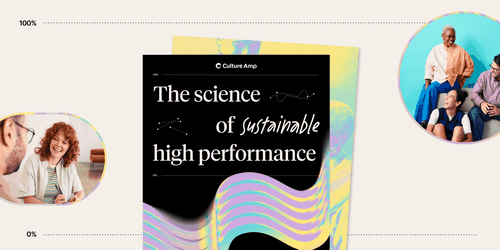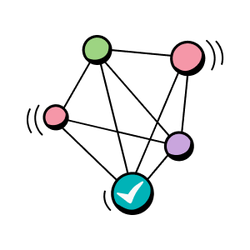
Article

What do employee engagement, productivity, performance, satisfaction, and retention all have in common? They’re all things that organizations want to improve. But there’s another big commonality: They’re all outcomes of a solid employee experience.
Your employee experience captures everything that people encounter and observe over the course of their employment with your organization – and getting it right enhances all of the above.
“Our research shows that more engaged employees perform 15-20% better on average than those employees that are less engaged,” explains Liz Culhane, Senior People Scientist at Culture Amp, in a recent webinar. Engaged employees:
For people leaders, the importance of the employee experience is intuitive and undeniable. “Yet, we know that the current environment is very complex,” Liz says, which is inspiring “many leaders to cut back.”
Programs that directly impact the employee experience are often among the first to get cut – especially since the return on investment from those efforts feels ambiguous and hard to define.
Convincing your organization to prioritize the employee experience requires more than impassioned speeches – you need a business case backed by real data and evidence.
This is where a lot of organizations get stuck. Fortunately, Ken Matos, Global Director of Customer People Science at Culture Amp, outlined a five-stage framework for identifying the value in people analytics and employee experience activities as well as clearly illustrating that value to company decision-makers. At each stage, he uses a fictional company, Hooli, as an example:
“This is usually where an organization is still making decisions based on intuition,” Ken shares. They might have stories or assumptions, but not a lot of evidence or numbers. “You can debate which story is more representative of your employees and it tends to be a fight among personalities rather than facts,” he adds.
In this stage, companies realize the opportunity to make better and more efficient decisions using data. Collecting that data requires some upfront work and investment, and “it can be hard to convince a leader that it is worth the time and effort to do that,” Ken says.
Example: Hooli leaders regularly complain that they can’t retain high performers, but no one really knows why. There’s also no standard process for defining a high performer beyond each manager’s personal opinion.
Some of the most convincing material emerges in this stage – as organizations set goals, collect data, and build a narrative that describes both what’s happening and what the possibilities are if they make changes.
When setting goals, get as specific as possible both with what you’re aiming to achieve as well as what data you’ll eventually need to prove your success.
“Very often, people will run in and do some sort of survey or launch a performance process without defining what they’re hoping to get from it in a very clear and concrete way,” Ken says. Clear metrics are easy to pass from stakeholder to stakeholder and make the definition of success more intuitive and relevant for leaders – which makes the case for people analytics far more compelling.
As you explore how to best demonstrate ROI, Ken cautions not to lose track of where the actual cost savings are. Take turnover as just one example – reducing turnover doesn’t always in and of itself reduce costs. Being able to scale back your recruiting efforts is where the real savings are, but that requires recognition and action.
“If you don’t recognize that turnover has gone down and then scale back those efforts to match, you won’t see the ROI which can really impact your argument,” Ken says.
Example: Hooli focuses on turnover among high performers, with a goal of reducing turnover of top salespeople from 15% to 10% so they can scale back expensive recruiting efforts. Through exit and engagement surveys in Culture Amp, Hooli learns that their high performers are most likely to leave when they feel like their careers are stagnating due to a lack of manager support for career growth.
This is the stage when organizations start developing a theory of change, along with action, motivation, and enablement strategies. These three strategies are equally important:
Ken says many organizations make the mistake of focusing exclusively on action. “They have a good plan, but they don’t know how they’re going to motivate or enable anyone else to act on it,” he explains.
It’s also important to align your motivational strategies with the people you’re speaking to. The talking points you use for shareholders will likely be different than the ones you use with employees.
When selling the change or effort to employees in particular, emphasize that you’re meeting a demand. For example, Ken says, “‘You all told us you wanted this. We are now taking action. This is us listening to you.’ It begins to give them a sense of autonomy and influence that can drive people to want to participate in things.”
Example: Hooli builds an action plan focused on offering more development opportunities to high-performing salespeople. This includes individual development plans, more structured manager coaching, and internal communications highlighting that employees asked for this support in surveys.
At this stage, organizations determine whether or not they have achieved the goal. Do they see any real improvements in business metrics like turnover, productivity, profitability, or whatever else they set their sights on?
Again, Ken emphasizes the importance of pre-planning how you’ll measure ROI on these goals. Before making a change, you need a solid plan for how you’ll illustrate impact. This means not only knowing the data you’ll need but also what department you need it from and how they’ll collect it.
“I’ve worked with so many customers who have gotten through to stage three and then realize they never figured out how to show that the things they were doing were actually effective,” he says.
Example: Hooli planned ahead to assess the effectiveness of their efforts. One year later, they would see if high-performing salespeople reported having more manager support for career growth and if turnover had decreased. In the interim, they used a series of pulse surveys to confirm progress. In one year, they found teams using the tools increased their manager support ranking by 10 points and that turnover decreased by 9%. Now they can scale back expensive recruiting efforts and see real cost savings.
Your employee experience isn’t static. There are always new opportunities to improve, particularly if you commit to ongoing assessments.
However, organizations have the tendency to view people analytics or employee experience initiatives as discrete projects rather than part of a continual improvement cycle.
“By looking at it as projects that begin and end, you lose a lot of opportunity to build momentum and create a real people analytics program,” Ken shares. Commit to constant learning and iteration – you’re never truly done using data to improve the employee experience.
Example: While Hooli’s effort was a success, not everyone participated. Their next step is to revisit their motivation and enablement strategies to better understand how they can decrease the population of holdouts, help these high performers succeed, and enhance ROI even further.
Following the above process will help you ensure that your people analytics and employee experience initiatives result in clear ROI conversations. But let’s go beyond the hypothetical example to look at the ROI of some real-world Culture Amp customers:
P&N Group:
Auto Trader:
TMF Group:
As organizations grapple with strapped resources and budgets, it’s tempting to think that employee experience initiatives – including the people analytics you use to support them – are easy cuts.
However, failing to prioritize the employee experience, especially during times of change, can have significant and measurable impacts on engagement, productivity, performance, satisfaction, and retention.
In short, when it comes to people analytics and employee experience programs, the return on investment is there – you just need to be prepared to demonstrate it.

See what a complete employee experience solution can do for your organization.